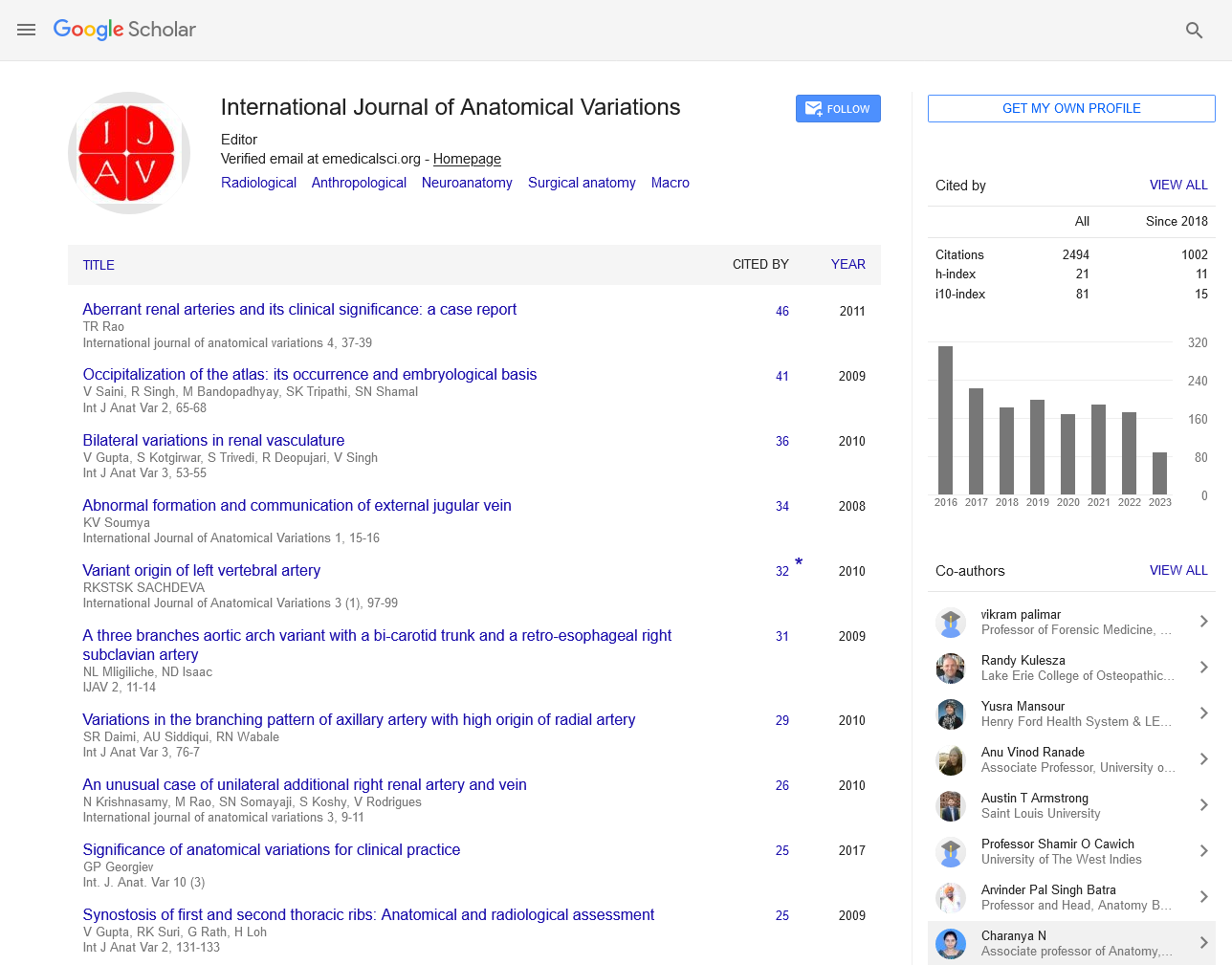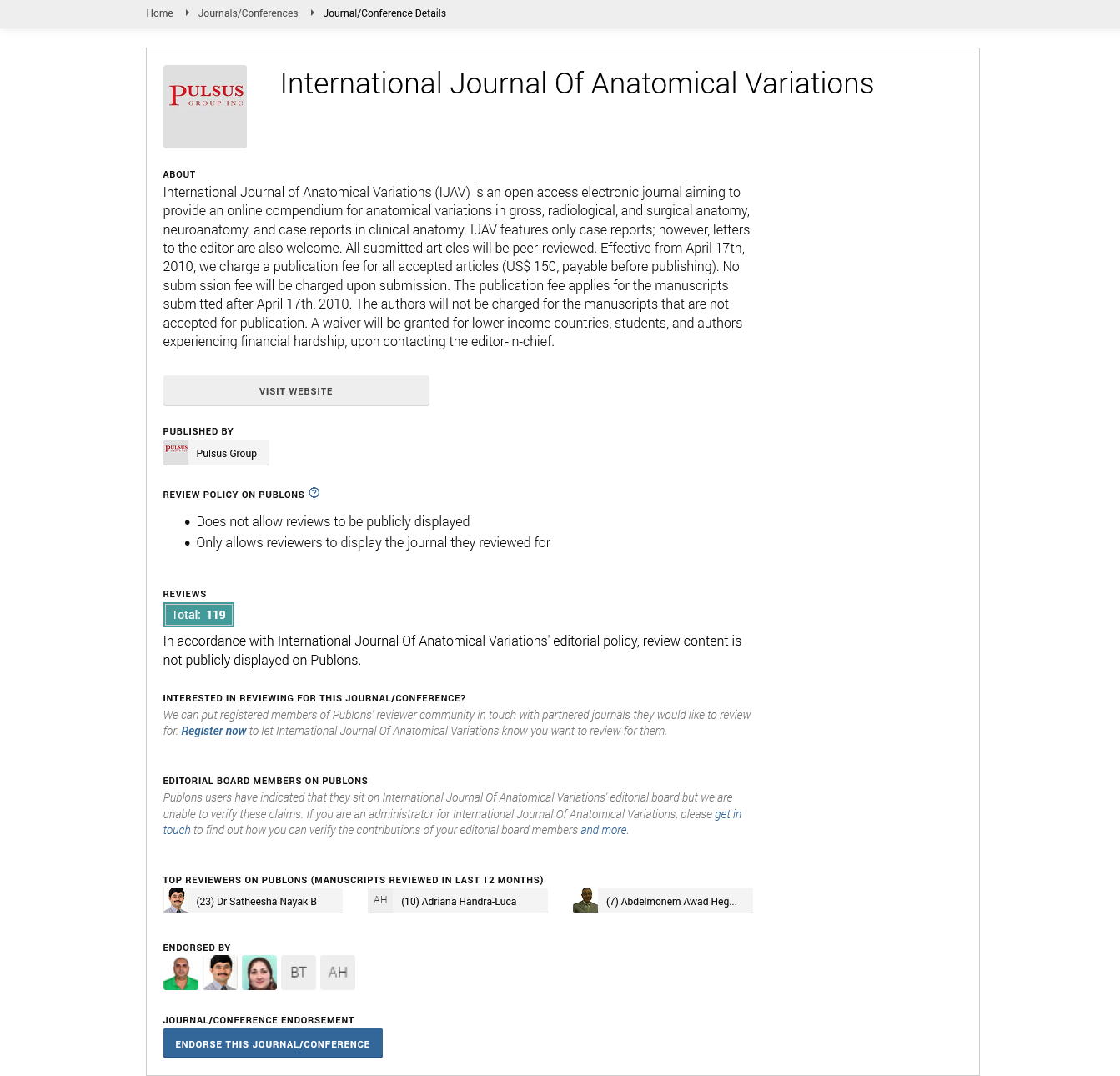Variations in the Structure of the Anterior Communicating Artery and Its Impact on Cerebral Aneurysm Formation
Received: 02-Jan-2025, Manuscript No. ijav-25-7539; Editor assigned: 04-Jan-2025, Pre QC No. ijav-25-7539 (PQ); Reviewed: 18-Jan-2025 QC No. ijav-25-7539; Revised: 24-Jan-2025, Manuscript No. ijav-25-7539 (R); Published: 31-Jan-2025, DOI: 10.37532/1308-4038.18(1).471
Citation: Akinyemi AO. Variations in the Structure of the Anterior Communicating Artery and Its Impact on Cerebral Aneurysm Formation. Int J Anat Var. 2025;18(1): 711-712.
This open-access article is distributed under the terms of the Creative Commons Attribution Non-Commercial License (CC BY-NC) (http://creativecommons.org/licenses/by-nc/4.0/), which permits reuse, distribution and reproduction of the article, provided that the original work is properly cited and the reuse is restricted to noncommercial purposes. For commercial reuse, contact reprints@pulsus.com
INTRODUCTION
The The anterior communicating artery (ACoA) plays a crucial role in the cerebral circulatory system, acting as a bridge that connects the left and right anterior cerebral arteries, providing collateral blood flow to the brain. Variations in the structure of the ACoA are relatively common and can have significant clinical implications, particularly in the formation of cerebral aneurysms. The presence of certain structural anomalies in the ACoA may predispose individuals to the development of aneurysms, a condition that can result in devastating neurological consequences if not identified and treated early. This article explores the various structural variations of the ACoA, their potential mechanisms in aneurysm formation, and the clinical implications for diagnosis and treatment [1].
ANATOMICAL VARIATIONS OF THE ANTERIOR COMMUNICATING ARTERY
The anterior communicating artery is part of the circle of Willis, a critical vascular structure that ensures collateral circulation to the brain. Anatomically, the ACoA is typically a short vessel that connects the two anterior cerebral arteries (ACAs) and lies just above the optic chiasm. However, several variations in its structure are observed in the general population. These variations can affect the size, shape, and configuration of the ACoA, as well as its relationship with the adjacent arteries. One common variation is the hypoplasia or agenesis of the ACoA, where the artery is either absent or underdeveloped. In these cases, the two anterior cerebral arteries are typically connected by a more robust collateral circulation, often through the posterior communicating arteries. While these cases may not directly increase the risk of aneurysm formation, the altered hemodynamics may contribute to other vascular abnormalities in the brain. Another frequently observed variation is the aneurysmal dilation of the ACoA itself. This is typically seen in individuals who present with ACoA aneurysms, a condition where the artery forms an abnormal outpouching due to weakening of the arterial wall. This aneurysmal dilation is more commonly found in the proximal part of the ACoA, where the artery meets the anterior cerebral arteries. In some cases, there is an asymmetry in the size of the anterior cerebral arteries or the ACoA, with one side being larger than the other. This asymmetry can result in altered blood flow dynamics, increasing the likelihood of hemodynamic stress on certain areas of the ACoA, predisposing it to aneurysm formation. Additionally, fenestration of the ACoA, where the artery divides into two separate lumens before reconverging, can lead to an increased risk of aneurysm formation at the site of the fenestration due to disturbed blood flow. These structural variations may not always result in clinical symptoms, but their presence can contribute to the development of aneurysms or increase the risk of rupture in individuals who already have cerebral aneurysms [2].
MECHANISMS OF CEREBRAL ANEURYSM FORMATION
Cerebral aneurysms are pathological dilations of the arterial wall, typically occurring at branching points where blood flow dynamics are altered. The anterior communicating artery, due to its critical role in connecting the two anterior cerebral arteries, is particularly susceptible to aneurysm formation. The exact mechanisms behind this increased susceptibility are multifactorial, involving both hemodynamic and structural factors. One key factor is the hemodynamic stress exerted on the ACoA due to variations in blood flow. In the case of structural anomalies such as asymmetry in the size of the ACoA or the anterior cerebral arteries, blood flow may become turbulent or excessively forceful at certain points along the artery. This increased flow and pressure can result in the weakening of the arterial wall, particularly at sites where the artery branches or bends, creating an environment conducive to aneurysm formation. Another factor is the structural integrity of the arterial wall. The ACoA is a relatively small artery, and as such, it is more prone to structural weaknesses that can lead to aneurysm formation. Conditions such as arterial dysplasia, connective tissue disorders (e.g., Ehlers-Danlos syndrome), and hypertension can further exacerbate the vulnerability of the ACoA to aneurysmal rupture. The presence of structural variations such as fenestration or hypoplasia can also alter the normal vascular architecture, leading to areas of increased wall stress and an elevated risk of aneurysm formation [3].
PREVALENCE OF ACOA VARIATIONS AND ANEURYSM RISK
The prevalence of structural variations in the ACoA and their relationship to cerebral aneurysm formation is well-documented in the literature. Studies suggest that ACoA aneurysms account for approximately 20-35% of all intracranial aneurysms, making them one of the most common sites for aneurysm formation in the brain. Among individuals with cerebral aneurysms, those with structural variations of the ACoA, such as asymmetry, fenestration, or hypoplasia, are at a higher risk of developing aneurysms at this location. The presence of a fenestrated ACoA has been shown to increase the risk of aneurysm formation due to altered flow patterns that increase wall stress. Similarly, ACoA hypoplasia or agenesis can alter the distribution of blood flow in the anterior cerebral arteries, leading to compensatory mechanisms that may increase the vulnerability of certain arterial segments to aneurysm formation. These variations are often seen in patients with a family history of aneurysms, suggesting a genetic component that predisposes certain individuals to develop these vascular anomalies [4].
CLINICAL IMPLICATIONS FOR DIAGNOSIS AND TREATMENT
The presence of anatomical variations in the ACoA has significant clinical implications, particularly in the diagnosis, management, and surgical treatment of cerebral aneurysms. Early identification of structural abnormalities in the ACoA is crucial for assessing an individual’s risk of aneurysm formation and rupture. Diagnostic tools such as magnetic resonance angiography (MRA), computed tomography angiography (CTA), and digital subtraction angiography (DSA) are essential for accurately visualizing these vascular anomalies and determining the extent of aneurysms in the ACoA region. For patients with asymptomatic ACoA variations, regular monitoring and surveillance are recommended to detect the early signs of aneurysm development. In cases where an aneurysm is detected, the decision to treat depends on factors such as aneurysm size, location, and patient-specific factors like age, comorbidities, and overall health. For smaller, unruptured aneurysms, a conservative approach may be appropriate, with regular follow-up imaging to monitor changes over time. However, for patients with larger aneurysms or those exhibiting symptoms such as headache, neurological deficits, or subarachnoid hemorrhage, surgical intervention may be necessary. Treatment options include endovascular coiling, which involves the insertion of a catheter through the femoral artery to the aneurysm site, where coils are placed to induce clotting and seal off the aneurysm. Surgical clipping is another option, particularly for large or complex aneurysms, where a clip is placed at the base of the aneurysm to prevent blood flow into the sac [5].
CONCLUSION
Variations in the structure of the anterior communicating artery can significantly impact the development of cerebral aneurysms. Structural abnormalities such as hypoplasia, fenestration, and asymmetry can lead to altered hemodynamic conditions, increasing the risk of aneurysm formation at this critical site. Given the high prevalence of ACoA aneurysms and the potential for catastrophic outcomes if ruptured, early detection and monitoring of structural variations are essential for managing patients at risk. A comprehensive understanding of the anatomical variations of the ACoA, combined with advances in imaging technology, has improved the ability to diagnose and treat cerebral aneurysms effectively, ultimately improving patient outcomes.
REFERENCES
- Cui RR, Wright JD, Hou JY. Uterine leiomyosarcoma: a review of recent advances in molecular biology, clinical management and outcome.BJOG: Int. J Obstet Gynaecol. 2017; 124(7):1028–1037.
- Santos P, Cunha TM. Uterine sarcomas: Clinical presentation and MRI features.Diagnostic and Interventional Radiology. 2015; 21(1):4–9.
- Cree IA, Tan PH, Travis WD, Wesseling Pet al.Counting mitoses: SI (ze) matters!Modern Pathology. 2021; 34:1651–1657.
- Huang YT, Huang YL, Ng KK, Lin G. Current status of magnetic resonance imaging in patients with malignant uterine neoplasms: A review.KJR. 2019; 20(1):18–33.
- Hughes L, Roex A, Parange A. STUMP, a surprise finding in a large fibroid uterus in a 20-year-old woman.Int J Womens Health. 2018; 10:211–214.
Indexed at, Google Scholar, Crossref
Indexed at, Google Scholar, Crossref
Indexed at, Google Scholar, Crossref
Indexed at, Google Scholar, Crossref






